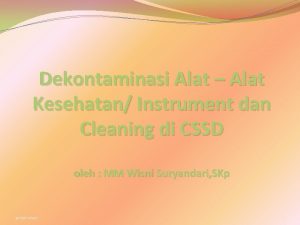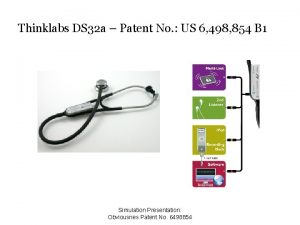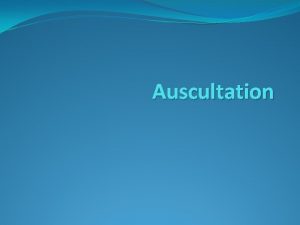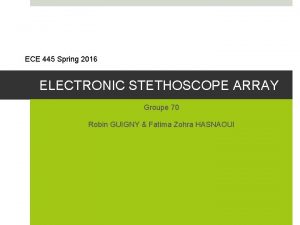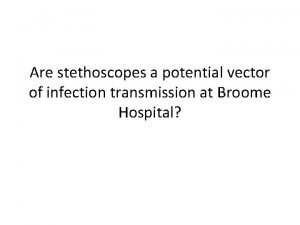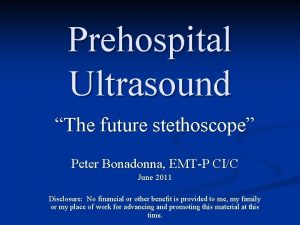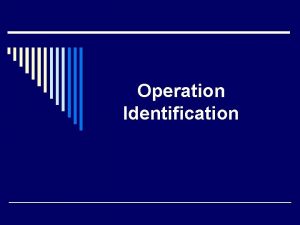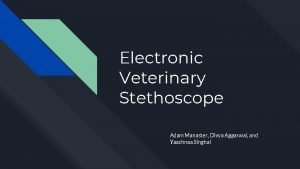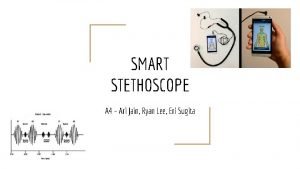Stethoscope and otoophtalmoscope o principles of operation function











- Slides: 11

Stethoscope and oto/ophtalmoscope o principles of operation function use scientific principles o construction components system diagram inputs/outputs o troubleshooting identifying common faults replacing components rectifying faults o safety considerations user and patient safety 13. 3. 9 Maintain a stethoscope and oto/ophthalmoscope. Unit B 13. 3 Maintaining General Bedside Nursing Equipment Module 279 18 B Medical Instrumentation I © dr. Chris R. Mol, BME, NORTEC, 2015

Function What is a stethoscope ? A stethoscope is an acoustic medical device for auscultation, or listening to the internal sounds of the human body. It is often used to listen to lung and heart sounds, the intestines and blood flow in arteries and veins. In combination with a sphygmomanometer, it is used to measure blood pressure. What is an otoscope ? An otoscope is an optical medical device that is used to look into the ears. Healthcare providers use otoscopes to screen for illness during regular check-ups and also to investigate ear symptoms, e. g. to identify infection What is an ophthalmoscope? An ophthalmoscope is an optical medical device that allows a healthcare provider to see the backside (fundus) of the eye, as part of an eye examination. © dr. Chris R. Mol, BME, NORTEC, 2015 Maintain a stethoscope and oto/ophthalmoscope

Use: everywhere, often as part of routine examination Otoscopes are often sold with ophthalmoscopes as a diagnostic set. © Otoscopes are also used for examining patients' noses and upper throats. dr. Chris R. Mol, BME, NORTEC, 2015 Maintain a stethoscope and oto/ophthalmoscope

Scientific principles: ophtalmoscope © dr. Chris R. Mol, BME, NORTEC, 2015 Maintain a stethoscope and oto/ophthalmoscope

Stethoscope Acoustic stethoscopes operate on the transmission of sound from the chest piece, via air-filled hollow tubes, to the listener's ears. The chest piece usually consists of two sides that can be placed against the patient for sensing sound; a diaphragm (plastic disc) and a bell (hollow cup). If the diaphragm is placed on the patient, body sounds vibrate the diaphragm, creating acoustic pressure waves which travel up the tubing to the listener's ears. If the bell is placed on the patient, the vibrations of the skin directly produce acoustic pressure waves traveling up to the listener's ears. The bell transmits low frequency sounds, while the diaphragm transmits higher frequency sounds. © dr. Chris R. Mol, BME, NORTEC, 2015 Maintain a stethoscope and oto/ophthalmoscope

Electronic Stethoscope Electronic stethoscopes overcome the low sound levels by electronically amplifying body sounds. Electronic stethoscopes require conversion of acoustic sound waves to electrical signals which can then be amplified and processed for optimal listening. Because the sounds are transmitted electronically, an electronic stethoscope can be a wireless device, can be a recording device, and can provide noise reduction and signal enhancement. © dr. Chris R. Mol, BME, NORTEC, 2015 Maintain a stethoscope and oto/ophthalmoscope

Otoscope The most commonly used otoscopes consist of a handle and a head. The head contains a light source and a simple low-power magnifying lens. The front end of the otoscope has an attachment for disposable plastic ear specula. The examiner looks through a lens on the rear of the instrument to see inside the ear canal. In many models, the lens can be removed, which allows the examiner to insert instruments through the otoscope into the ear canal, such as for removing earwax. Most models also have an insertion point for a bulb capable of pushing air through the speculum which is called pneumatic otoscope. This puff of air allows an examiner to test the mobility of the eardrum (tympanic membrane). © dr. Chris R. Mol, BME, NORTEC, 2015 A speculum is a tool for investigating body orifices, with a form dependent on the orifice for which it is designed. Maintain a stethoscope and oto/ophthalmoscope

Direct Ophthalmoscope The direct ophthalmoscope is an instrument about the size of a small flashlight (torch) with several lenses that can magnify up to about 15 times. This type of ophthalmoscope is most commonly used during a routine physical examination. © dr. Chris R. Mol, BME, NORTEC, 2015 Maintain a stethoscope and oto/ophthalmoscope

Indirect Ophthalmoscope An indirect ophthalmoscope contains a light attached to a headband, in addition to a small handheld lens. It provides a wider view of the inside of the eye. It is used for peripheral viewing of the retina. In addition, it allows a better view of the fundus of the eye, even if the lens is clouded by cataracts. An indirect ophthalmoscope can be either monocular or binocular. © dr. Chris R. Mol, BME, NORTEC, 2015 Maintain a stethoscope and oto/ophthalmoscope

Trouble shooting Stethoscopes require little maintenance apart from replacement of lost, cracked, or broken parts, such as ear-pieces and diaphragms. On the older types, the tubing may perish and need replacing. While it is possible to buy proper, but expensive, stethoscope tubing, ordinary tubing of a suitable size may be fitted. Most newer stethoscopes have tubing that does not perish, though it can become sticky if certain chemicals come into contact with it. If nothing can be heard through a stethoscope, check whether: • The earpieces are blocked; if they are, unscrew them, push the blockage out and clean with a little spirit. • The diaphragm is missing or split; replacements can be purchased or can be made out of a piece of radiographic film or similar plastic sheet. • The tube is split. © dr. Chris R. Mol, BME, NORTEC, 2015 Maintain a stethoscope and oto/ophthalmoscope

END The creation of this presentation was supported by a grant from THET: see https: //www. thet. org/
 Klasifikasi spaulding
Klasifikasi spaulding Thinklabs ds32a digital stethoscope
Thinklabs ds32a digital stethoscope Medical term for listening with a stethoscope
Medical term for listening with a stethoscope Robin guigny
Robin guigny Stethoscopes hospital hill
Stethoscopes hospital hill Best prehospital stethoscope
Best prehospital stethoscope Perform function operations and composition
Perform function operations and composition Front office section
Front office section Chapter 5 principles of engine operation
Chapter 5 principles of engine operation System 360 principles of operation
System 360 principles of operation Function operations multiplication
Function operations multiplication Operation management objectives
Operation management objectives
